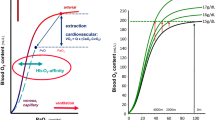Summary
Six well-trained male cross-country skiers trained for 7 days at 2700 m above sea level, their accommodation being at 1695 m. Blood samples for haemoglobin concentration [Hb], erythropoietin concentration [EPO] and reticulocyte count were collected before, during and after altitude exposure. Packed cell volume (PCV), red blood cell count (RBC), transferrin-iron saturation, mean red cell volume (MCV), mean corpuscular haemoglobin concentration (MCHC), maximal oxygen uptake, maximal achieved ventilation and heart rate were determined pre- and postaltitude exposure. The [EPO] increased significantly from prealtitude (mean 36 mU·ml−1, SD 5) to maximal altitude values (mean 47 mU·ml−1, SD 3). The [Hb] had increased significantly above pre-altitude values (mean 8.8 mmol·l−1, SD 0.5) on day 2 (mean 9.1 mmol·l−1, SD 0.4) and day 7 (mean 9.4 mmol·l−1, SD 0.4) at altitude and on day 4 postaltitude (mean 9.2 mmol·l−1, SD 0.4). The reticulocyte counts had increased significantly above pre-altitude values (mean 6‰, SD 3‰) on day 3 at altitude (mean 12‰, SD 8‰) and day 4 postaltitude (mean 10‰, SD 5‰). The RBC counts had increased on the 4th postaltitude day. The transferrin-iron saturation had decreased below pre-altitude values (mean 23%, SD 4%) on day 4 postaltitude (mean 14%, SD 5%) and had increased on day 11 postaltitude (mean 22%, SD 7%). There were no significant changes in MCV, MCHC, PCV, maximal oxygen uptake and maximal achieved ventilation, and heart rate pre- to postaltitude. These observations demonstrated an erythropoietic response to the altitude training which was not sufficient to increase the postaltitude maximal oxygen uptake.
Similar content being viewed by others
References
Banister EW, Hamilton CL (1985) Variations in iron status with fatigue modelled from training in female distance runners. Eur J Appl Physiol 54:16–23
Dill DB, Horvath SM, Dahms TE, Parker RE, Lynch JR (1969) Hemoconcentration at altitude. J Appl Physiol 27:514–518
Faulkner JA, Daniels JT, Balke B (1967) Effects of training at moderate altitude on physical performance capacity. J Appl Physiol 23:85–89
Faura J, Ramos J, Reynafarje C, English E, Finne P, Finch CA (1969) Effect of altitude on erythropoiesis. Blood 33:668–676
Goldwasser E (1984) Erythropoietin and its mode of action. Blood Cells 10:147–162
Hansen LR, Bro-Rasmussen T (1985) Some parameters of training at moderate altitude. Report no. 194. August Krogh Institute, University of Copenhagen
Hunding A, Jordal R, Paulev PE (1981) Runners anemia and iron deficiency. Acte Med Scand 209:315–318
Jelkmann W (1986) Renal erythropoietin: properties and production. Rev Physiol Biochem Pharmacol 104:139–215
Nielsen OJ (1988) Determination of human erythropoietin by radioimmunoassay. Method and clinical data. Clin Chim Acta 176:303–314
Saltin B, Grover RF, Blomgvist CG, Hartley H, Johnson R Jr (1968) Maximal oxygen uptake and cardiac output after 2 weeks at 4300 m. J Appl Physiol 25:400–409
Siri WE, Van Dyke DC, Pollycove M, Parker HG, Cleveland AS (1966) Early erythropoietin, blood and physiological responses to severe hypoxia in man. J Appl Physiol 21:73–80
Stokke KT, Rootwelt K, Wergeland R, Vale JR (1986) Changes in plasma and red cell volumes during exposure to high altitude. Scand J Clin Lab Invest 46 [Suppl]:113–117
Ward MP, Milledge JS, West JB (1989) High altitude medicine and physiology. Chapman and Hall, London, pp 168–169
Author information
Authors and Affiliations
Rights and permissions
About this article
Cite this article
Klausen, T., Mohr, T., Ghisler, U. et al. Maximal oxygen uptake and erythropoietic responses after training at moderate altitude. Europ. J. Appl. Physiol. 62, 376–379 (1991). https://doi.org/10.1007/BF00634976
Accepted:
Issue Date:
DOI: https://doi.org/10.1007/BF00634976




